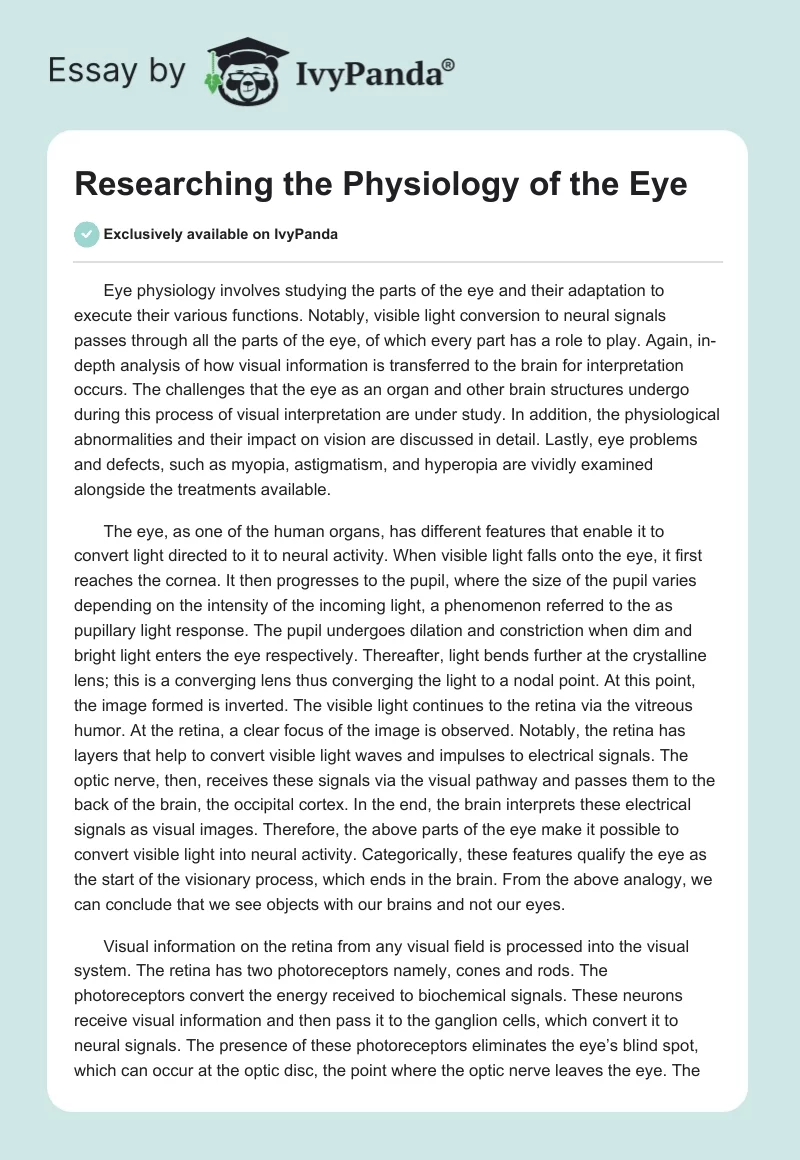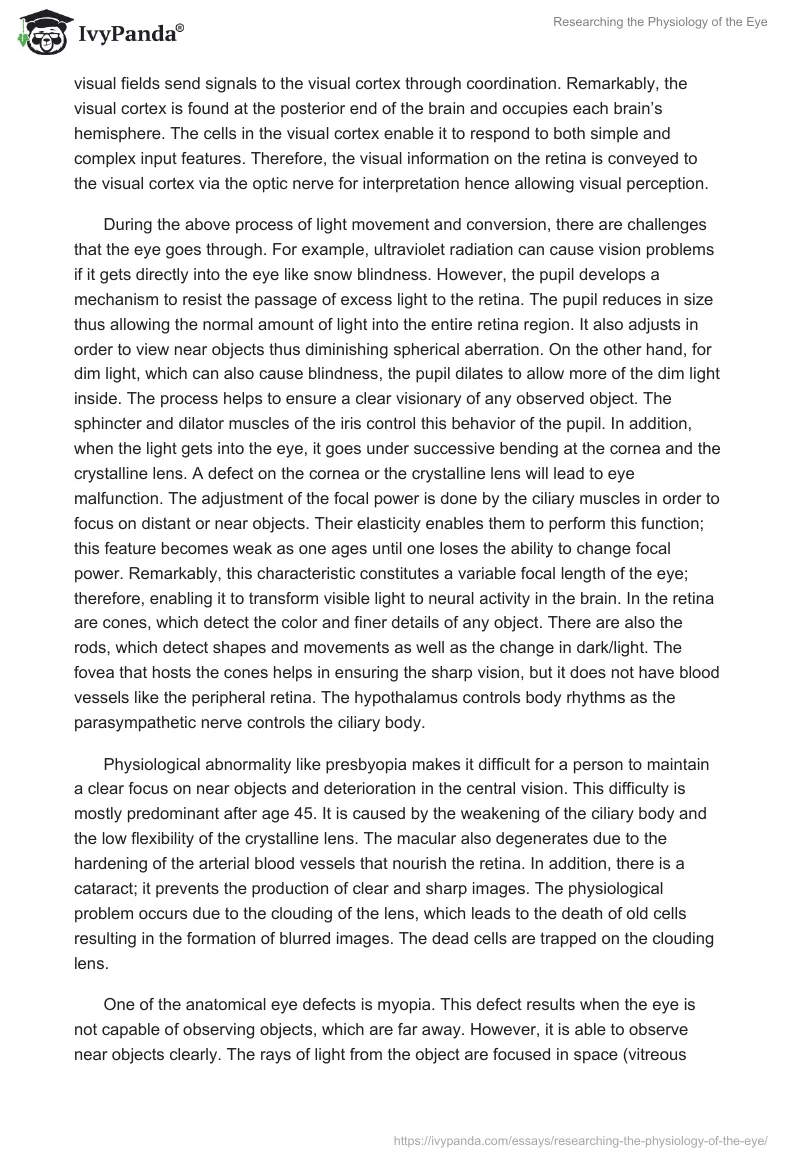Eye physiology involves studying the parts of the eye and their adaptation to execute their various functions. Notably, visible light conversion to neural signals passes through all the parts of the eye, of which every part has a role to play. Again, in-depth analysis of how visual information is transferred to the brain for interpretation occurs. The challenges that the eye as an organ and other brain structures undergo during this process of visual interpretation are under study. In addition, the physiological abnormalities and their impact on vision are discussed in detail. Lastly, eye problems and defects, such as myopia, astigmatism, and hyperopia are vividly examined alongside the treatments available.
The eye, as one of the human organs, has different features that enable it to convert light directed to it to neural activity. When visible light falls onto the eye, it first reaches the cornea. It then progresses to the pupil, where the size of the pupil varies depending on the intensity of the incoming light, a phenomenon referred to the as pupillary light response. The pupil undergoes dilation and constriction when dim and bright light enters the eye respectively. Thereafter, light bends further at the crystalline lens; this is a converging lens thus converging the light to a nodal point. At this point, the image formed is inverted. The visible light continues to the retina via the vitreous humor. At the retina, a clear focus of the image is observed. Notably, the retina has layers that help to convert visible light waves and impulses to electrical signals. The optic nerve, then, receives these signals via the visual pathway and passes them to the back of the brain, the occipital cortex. In the end, the brain interprets these electrical signals as visual images. Therefore, the above parts of the eye make it possible to convert visible light into neural activity. Categorically, these features qualify the eye as the start of the visionary process, which ends in the brain. From the above analogy, we can conclude that we see objects with our brains and not our eyes.
Visual information on the retina from any visual field is processed into the visual system. The retina has two photoreceptors namely, cones and rods. The photoreceptors convert the energy received to biochemical signals. These neurons receive visual information and then pass it to the ganglion cells, which convert it to neural signals. The presence of these photoreceptors eliminates the eye’s blind spot, which can occur at the optic disc, the point where the optic nerve leaves the eye. The visual fields send signals to the visual cortex through coordination. Remarkably, the visual cortex is found at the posterior end of the brain and occupies each brain’s hemisphere. The cells in the visual cortex enable it to respond to both simple and complex input features. Therefore, the visual information on the retina is conveyed to the visual cortex via the optic nerve for interpretation hence allowing visual perception.
During the above process of light movement and conversion, there are challenges that the eye goes through. For example, ultraviolet radiation can cause vision problems if it gets directly into the eye like snow blindness. However, the pupil develops a mechanism to resist the passage of excess light to the retina. The pupil reduces in size thus allowing the normal amount of light into the entire retina region. It also adjusts in order to view near objects thus diminishing spherical aberration. On the other hand, for dim light, which can also cause blindness, the pupil dilates to allow more of the dim light inside. The process helps to ensure a clear visionary of any observed object. The sphincter and dilator muscles of the iris control this behavior of the pupil. In addition, when the light gets into the eye, it goes under successive bending at the cornea and the crystalline lens. A defect on the cornea or the crystalline lens will lead to eye malfunction. The adjustment of the focal power is done by the ciliary muscles in order to focus on distant or near objects. Their elasticity enables them to perform this function; this feature becomes weak as one ages until one loses the ability to change focal power. Remarkably, this characteristic constitutes a variable focal length of the eye; therefore, enabling it to transform visible light to neural activity in the brain. In the retina are cones, which detect the color and finer details of any object. There are also the rods, which detect shapes and movements as well as the change in dark/light. The fovea that hosts the cones helps in ensuring the sharp vision, but it does not have blood vessels like the peripheral retina. The hypothalamus controls body rhythms as the parasympathetic nerve controls the ciliary body.
Physiological abnormality like presbyopia makes it difficult for a person to maintain a clear focus on near objects and deterioration in the central vision. This difficulty is mostly predominant after age 45. It is caused by the weakening of the ciliary body and the low flexibility of the crystalline lens. The macular also degenerates due to the hardening of the arterial blood vessels that nourish the retina. In addition, there is a cataract; it prevents the production of clear and sharp images. The physiological problem occurs due to the clouding of the lens, which leads to the death of old cells resulting in the formation of blurred images. The dead cells are trapped on the clouding lens.
One of the anatomical eye defects is myopia. This defect results when the eye is not capable of observing objects, which are far away. However, it is able to observe near objects clearly. The rays of light from the object are focused in space (vitreous fluid) in front of the retina. It is also known as nearsightedness. This problem arises because of the high refractive index of the eyeballs. Myopia can be corrected when the patient puts on glasses, which have concave lenses. There is also hyperopia, which occurs when light from near objects converges behind the retina, but the eye is able to see clearly objects that are far. Here, the eyeballs are too short or have a low refractive index. It can be corrected by using contacts that have convex lenses in them. Lastly, there is also astigmatism, which is due to the convergence of light rays at numerous points. The rays can converge at the retina, in front of the retina and even behind simultaneously. It is worth noting that the non-uniformity of the cornea’s curvature is the cause of astigmatism. One can use a spherical cylindrical lens to correct astigmatism. The special spherical cylinder ensures that all the light converges at the walls of the retina.


